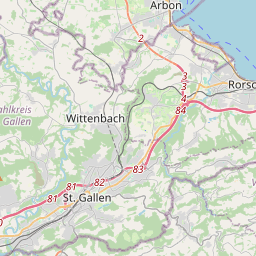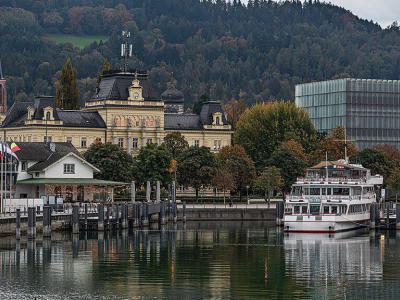
Bregenz Introduction Walking Tour (Self Guided), Bregenz
Bregenz, located where Austria meets Germany and Switzerland, contains many beautiful landmarks in both the historic and modern parts of the city. Discover Bregenz’s most popular attractions and learn about its history in the following orientation walk.
How it works: Download the app "GPSmyCity: Walks in 1K+ Cities" from Apple App Store or Google Play Store to your mobile phone or tablet. The app turns your mobile device into a personal tour guide and its built-in GPS navigation functions guide you from one tour stop to next. The app works offline, so no data plan is needed when traveling abroad.
Bregenz Introduction Walking Tour Map






Guide Name: Bregenz Introduction Walking Tour
Guide Location: Austria » Bregenz (See other walking tours in Bregenz)
Guide Type: Self-guided Walking Tour (Sightseeing)
# of Attractions: 17
Tour Duration: 2 Hour(s)
Travel Distance: 2.5 Km or 1.6 Miles
Author: Sandra
Sight(s) Featured in This Guide:
Guide Location: Austria » Bregenz (See other walking tours in Bregenz)
Guide Type: Self-guided Walking Tour (Sightseeing)
# of Attractions: 17
Tour Duration: 2 Hour(s)
Travel Distance: 2.5 Km or 1.6 Miles
Author: Sandra
Sight(s) Featured in This Guide:
- Martinsturm (St. Martin’s Tower)
- Altes Rathaus (Old Town Hall)
- Ehregutaplatz (Ehreguta Square)
- Fountain of the Minnesinger of Montfort
- Deuringschloessle (Deuring Castle)
- Kirche St. Gallus (Church of St. Gallus)
- Kapuzinerkloster (Capuchin Monastery)
- Palais Thurn and Taxis Art House
- Thurn-und-Taxis Park
- Gruenes Haus (Green House)
- Altes Landhaus (Old Country House)
- Vorarlberg Provincial Museum
- Kunsthaus Bregenz (Art House)
- Nepomukkapelle (St. Nepomuk Chapel)
- Kornmarktstrasse No. 7
- Port Bregenz
- Bregenz Promenad (Lake Promenade)
1) Martinsturm (St. Martin’s Tower) (must see)
The massive St. Martin's Tower, part of the medieval boundaries of the city, is Bregenz’s tallest landmark. This Baroque structure, used as a granary, was completed in 1602 when a story was added. The oldest part of this complex is the medieval St. Martin's Chapel from 1362. The chapel contains wonderful frescoes, the most significant being the Last Supper, which includes Mary Magdalen washing Christ's feet. The upper floor houses Vorarlberger Militarmuseum, which has fascinating Prehistoric and Roman sections, expositions of traditional clothes, and Romanesque and Gothic religious art. This Turkish style square tower features Central Europe’s largest onion dome with a beautiful view of the lake.
2) Altes Rathaus (Old Town Hall) (must see)
The Old Town Hall, located on Eponastrasse near Deuring Castle and St. Martin’s Tower, is a rather eye-catching house to passersby. This large yellow A-frame timber house dating back to the 17th century has an impressive gable roof with red and white shutters. It now serves as a private residence.
3) Ehregutaplatz (Ehreguta Square)
Ehreguta Square, located in the historic Upper Town, was named in honor of Guta, a beggar who saved the town during the Appenzell Wars in 1407. She had warned residents about an upcoming attack from Swiss conquerors. Nowadays, it is the location of the Deuring Castle Hotel, Montfortbrunnen Fountain and the corner house Ehreguta No. 1, which has a solar clock on its façade. Next door to this square you will find St. Martin’s Tower and the Old Town House.
4) Fountain of the Minnesinger of Montfort
Fountain of the Minnesinger of Montfort, located on Ehregutaplatz, includes images of Hugo von Montfort, after whom it was named. He was famous as a poet and a reputable politician. Hugo XII, Graf von Montfort-Bregenz was the most eminent personality of this notable family. An annual carnival is hosted at this beautiful fountain.
5) Deuringschloessle (Deuring Castle) (must see)
The small 16th century Deuring Castle, located in southwestern Bregenz, now serves as a hotel and gourmet restaurant. The present structure was developed based on the former medieval construction. Belonging to the von Deuring family in the late 1600s, the surviving brickwork was turned into a wonderful Baroque complex. Restored in 1989, this historic architecture preserves the local culture.
6) Kirche St. Gallus (Church of St. Gallus) (must see)
The Church of Saint Gallus stands on an isolated piece of high ground in Old Town Bregenz. The central portion of the building and the front sandstone porch-belfry were built around 1380 in the Gothic style. The porch-belfry is crowned by a Baroque castellated gable from the 15th century. The interior was designed in the Late Baroque and Roccoco styles in 1738 with a Baroque marble chancel, choir stalls by Mehrerau Abbey, and effigies of Saint Gallus, Saint Peter, Saint Ulrich, Saint Paul and Saint Nicolas.
7) Kapuzinerkloster (Capuchin Monastery) (must see)
The Capuchin Monastery, built in 1639, was a home for Capuchin monks and the sisters of Saint Claire until 2002. It has a lovely walkway with picturesque scenes, beautiful covered staircases, Saint Antonius Church and the small Lourdes Chapel, dedicated to the Blessed Virgin. Images of Christ, Saint Antonius and Saint Franziskus, an altarpiece with holy Antonius, a Mater Dolorosa sculpture and others can be found here.
8) Palais Thurn and Taxis Art House
The Palais Thurn and Taxis Art House, an international contemporary art center and the site of the Vorarlberg Association of Artists, was founded in 1984. It features meaningful expositions which change each month.
9) Thurn-und-Taxis Park
Thurn-und-Taxis Park is one of four historically valuable Vorarlberg gardens. This 16,000 square meter space has been carefully preserved in its original condition. It has a street entrance from the villa and two side buildings, with beautiful landscaping, a great variety of exotic trees, some over 100 years old, and shrubs surrounding it.
10) Gruenes Haus (Green House)
The Green House, on Montfortstrasse, which leads to the shore of Lake Constance, was designed by architect Willibald Braun and built in 1926. An example of Rationalistic architecture, its exterior combines elements of the 1920s, with expressionist arcades and bay window turrets. Today it serves as the headquarters for the Agriculture Chamber. A 2010 renovation plan calls for modern office and service facilities, though the exterior of this historic building will be preserved.
11) Altes Landhaus (Old Country House)
Old Country House is a council house and convention hall built by renowned Austrian architect Willibald Braun in 1921. This four-story Neoclassical building’s front is decorated with Ionic columns. It has a gabled roof with triangular frontons, and a gable mosaic by Joseph Huber-Feldkirch and corner sculpture by Josef Piffrader, both added in 1923. The central part of the Jahnstrasse façade has a lobe above the ground floor framed by the balcony.
12) Vorarlberg Provincial Museum (must see)
The Vorarlberg Provincial Museum, located on the northern side of Kornmarktplatz near the Art House, was built in 1903. This museum delves into the province's history, folk art and architecture. The ground floor exhibits artifacts from the Stone, Bronze and Iron Ages, and Roman objects from Brigantium (1th-4th century), a settlement to the west of the modern city center. The second floor showcases weapons, armor and ecclesiastical works of art from local churches, handicrafts, clothing and musical instruments from the Gothic and Renaissance periods. The third floor is devoted to Gothic art from the region’s religious sites.
13) Kunsthaus Bregenz (Art House)
The Kunsthaus Bregenz (KUB) is one of Europe’s grandest galleries for contemporary art - 1,880 m² of exhibition space. Commissioned by the State of Vorarlberg and designed by the Swiss architect Peter Zumthor, it was built between 1990 and 1997. Together with the Landestheater, it frames an open square between the old town and the lake. The KUB generally exhibits works of the artists who create specifically for the Kunsthaus. Its own collection comprises two core areas: “Archive Art Architecture” and “Contemporary Austrian Art.” Alongside exhibitions, the Kunsthaus runs an extensive educational program, publishes books, collections of essays, and catalogs, often in close collaboration with exhibiting artists and designers, such as Walter Nikkels or Stefan Sagmeister.
Sight description based on Wikipedia.
14) Nepomukkapelle (St. Nepomuk Chapel) (must see)
The Rococo Saint Nepomuk Chapel, devoted to Saint John of Nepomuk, patron saint of those in peril at sea, is a small rotunda crowned with a dome cupola. Erected in 1757, from 1995 to 1997 it was completely refurbished. Inside you will see an ornate altar, miraculous works of plaster and vivid frescoes. Nowadays it serves as the Hungarian Church, with room for a congregation of about 30.
15) Kornmarktstrasse No. 7
The three-story house on Kornmarktstrasse No. 7 got its present appearance due to a complete renovation in 1896. Its façade was designed in the Late Baroque style with gable elevations, the main façade featuring large circular and rectangular openings and a sculpture of the Madonna in the round niche from the late 19th century.
16) Port Bregenz
First mentioned in 1249, for centuries Port Bregenz has been repaired and extended to accommodate ships docking in the harbor. In 2009, it was enlarged and modernized, putting it closer to the railway station, with spacious parking in the adjoining garage and a restaurant.
17) Bregenz Promenad (Lake Promenade) (must see)
The Lake Promenade, established on the waterfront in the 1880s, has been added to over the years, now including several vistas, restaurants, cafes and piers. The shoreline offers an impressive view of the landscape. Located away from the bustle of the city, you can enjoy the lovely flags near the harbor, the shaded paths lined with trees or see a show at the music pavilion.
Walking Tours in Bregenz, Austria
Create Your Own Walk in Bregenz
Creating your own self-guided walk in Bregenz is easy and fun. Choose the city attractions that you want to see and a walk route map will be created just for you. You can even set your hotel as the start point of the walk.
Historical Buildings in Bregenz
Bregenz is home to many historic buildings, several of which were built between the 13th and 16th centuries. Federal High School, the Vorarlberg Land Theater and City Hall, located near the harbor, are landmarks of the Lower Town. Take the following tour to discover Bregenz’s best historic architecture.
Tour Duration: 3 Hour(s)
Travel Distance: 5.5 Km or 3.4 Miles
Tour Duration: 3 Hour(s)
Travel Distance: 5.5 Km or 3.4 Miles
The Most Popular Cities
/ view all


















